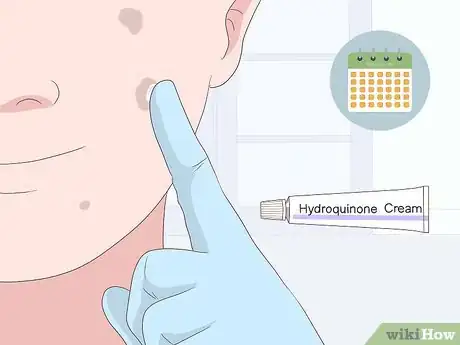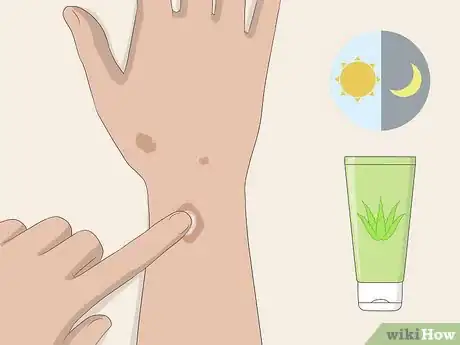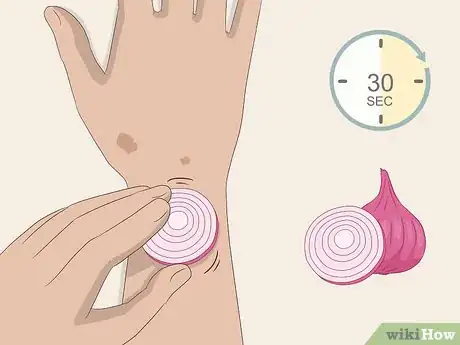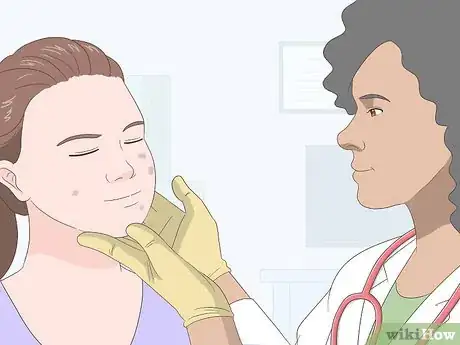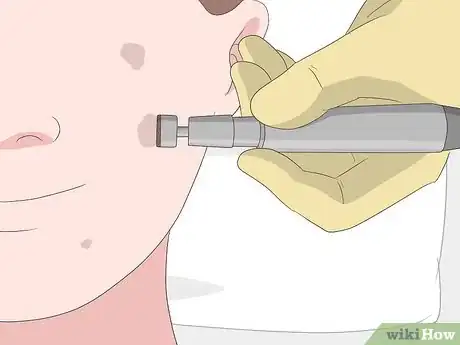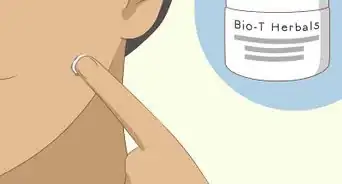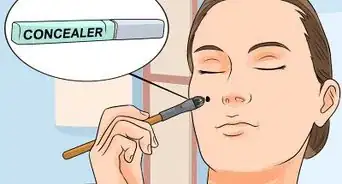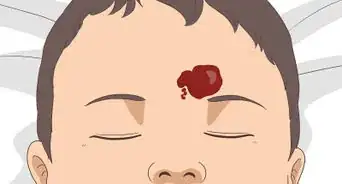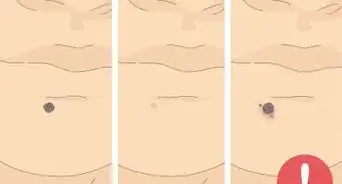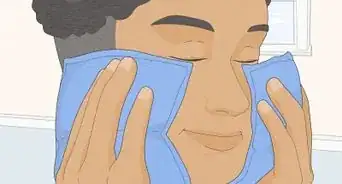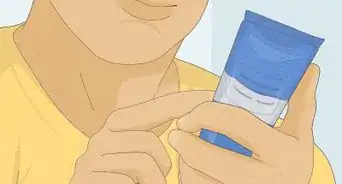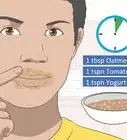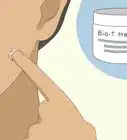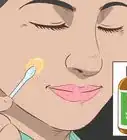This article was co-authored by Mohiba Tareen, MD. Mohiba Tareen is a board certified Dermatologist and the founder of Tareen Dermatology located in Roseville, Maplewood and Faribault, Minnesota. Dr. Tareen completed medical school at the University of Michigan in Ann Arbor, where she was inducted into the prestigious Alpha Omega Alpha honor society. While a dermatology resident at Columbia University in New York City, she won the Conrad Stritzler award of the New York Dermatologic Society and was published in The New England Journal of Medicine. Dr. Tareen then completed a procedural fellowship which focused on dermatologic surgery, laser, and cosmetic dermatology.
There are 11 references cited in this article, which can be found at the bottom of the page.
wikiHow marks an article as reader-approved once it receives enough positive feedback. In this case, 100% of readers who voted found the article helpful, earning it our reader-approved status.
This article has been viewed 1,162,790 times.
Sunspots appear as flat, brown spots on your skin and are caused by direct, prolonged exposure to ultraviolet (UV) rays. The spots can appear at any age and are usually not harmful. Sunspots affect people with lighter skin most frequently, but anyone can get them.[1] Sunspots are not dangerous, and there are many options available for treating sunspots. Treatment options include over-the-counter creams, natural treatments that you can try at home, and medical procedures to permanently remove sunspots.
Steps
Applying Over-The-Counter Products
-
1Spread a topical retinoid over sunspots to lighten them. Go to your local beauty supply store or drug store and look for an overnight cream or anti-aging cream that contains retinol (a type of retinoid). Wash your face before applying topical retinoids. Wait 20 minutes, and squeeze out a pea-sized dollop of topical retinoid cream onto 1 finger. Rub the cream into the sunspots on your face, neck, arms, and hands. Retinoids are derived from vitamin A and are a great way to lighten your sunspots. Apply the cream once daily until the spots have lightened.[2]
- Look for a label that contains retinyl palmitate, retinyl linoleate, retinaldehyde, propionic acid, or retinyl acetate.
-
2Apply hydroquinone to bleach away unwanted sunspots. Hydroquinone is another common OTC cream used to treat dark or large sunspots. Look for a "dark spot treatment" or "dark spot corrector" product at the drugstore and check the ingredient label for hydroquinone. Put on a pair of latex gloves before handling the cream. Apply a small dollop of the bleaching cream directly to each sunspot and rub it in with 1 gloved finger. Use the cream daily, or as often as directed on the packaging, until the spots have substantially lightened.[3]
- Hydroquinone works relatively slowly. You’ll need to apply the cream for 8–12 weeks to start seeing effects.[4]
- If you experience pain or feel a burning sensation when using a hydroquinone cream, wash your face and stop using the cream.
Advertisement -
3Try using a cream with glycolic acid, a type of AHA (alpha-hydroxy acid). Glycolic acid is thought to help exfoliate skin to “peel off” sunspots. However, some research also shows that glycolic acid used in high concentrations (20% concentration or more) might increase or exacerbate UV damage.[5]
- Use a glycolic acid product that has less than 20% concentration and be sure to apply sunscreen or sunblock for UV protection.
-
4Lighten spots with products that contain kojic acid at night before bed. Several common OTC creams contain kojic acid, and at the drugstore, you can often find kojic acid in products called "dark spot correctors." This acid—made from fermented rice—has been shown to reduce the appearance of sunspots. 30 minutes before you go to bed, apply a small dollop of the topical cream to sunspots on your face, hands, and arms and rub the cream into your skin. The product works slowly, so you’ll need to apply for several weeks or even a couple of months before you see results.[6]
- Look for kojic acid in cosmetic beauty products like lotions and skin creams. These contain relatively weak concentrations of the acid, typically between 1% and 4%. If you’re looking for skin products with kojic acid in your local drugstore or pharmacy, check the beauty and skincare aisle.
- If you have sensitive skin, products containing kojic acid can cause irritation, redness, and inflammation. If you notice these symptoms, stop using the cream.
Trying Natural Remedies
-
1Apply aloe vera gel twice a day to heal sun-damaged areas. Aloe has remarkable natural healing properties and is a great natural remedy to use on unwanted sunspots. If you’re using a cream, apply a generous amount to the skin of your face, arms, and other sunspot-afflicted areas once in the morning and once in the evening. If you’re using the leaves of an aloe plant, squeeze the pith out from a 1 inch (2.5 cm) section and smear it directly onto your sunspots.[7]
- Look for aloe vera gels at health-food stores or in homeopathic medicine sections. Large pharmacies may also carry aloe vera gel. Look near the sunscreen and other skincare products.
- If you’d prefer just to purchase an aloe plant, look at a large plant nursery.
-
2Take vitamin E capsules by mouth twice daily to reduce sunspots. Vitamin E has been proven to help lighten dark spots on the skin, including unwanted sunspots. Swallow 1 vitamin E tablet in the morning and 1 more at night to help lighten sunspots. Or, add vitamin E to your diet by upping your consumption of foods rich in vitamin E. These include foods like citrus fruits, papaya, spinach, broccoli, and tomatoes[8]
- You can purchase both vitamin E oral tablets and liquid gel at a large pharmacy or drugstore.
Tip: You can also break open vitamin E capsules and apply the gel directly to the sunspots. Apply the gel before you go to bed, and leave the vitamin E on your skin overnight.
-
3Slice a fresh lemon and apply it directly to your sunspots. Cut 1 large lemon into quarters and hold a lemon section against your sunspots for 10–15 minutes per day. Lemons are mildly acidic, and the acid in the fruit aids in lightening dark sunspots. You’ll begin to notice that your sunspots are visibly lighter after about 2 months of daily use.[9]
- Rather than throwing away the sections of lemon that you don’t use each day, store them in a plastic bag in your refrigerator and use them the next day.
- Daily lemon application can also help to remove any dead skin cells from your face, arms, and shoulders.
-
4Cut up a red onion and rub it over the sunspots. Take a sharp kitchen knife and chop 1 large red onion up into 6-8 large chunks. Pick up 1 of the onion chunks and rub it across a dark sunspot for about 30 seconds. The acid in the onion helps to lighten up the dark color of sunspots. Because the onion’s acid is relatively weak, you’ll need to continue the home treatment for months before you see much of a result.[10]
Tip: Red onion’s ability to clear up sunspots and to lighten your skin tone has been verified in a medical study. If you'd rather not apply onion directly to your face, look for a topical skin cream that contains dried red onion skin.[11]
Receiving Medical Treatment
-
1Visit a dermatologist if your sunspots don’t respond to OTC treatment. Some sunspots are tough to remove and don’t respond well to OTC creams and other products. If you’d like to remove or lighten the sunspots for cosmetic reasons, visit a local dermatologist and ask them to inspect your sunspots. Describe to them how long you’ve had the sunspots and mention what other treatments you’ve tried.[12]
- In some cases, you may need to visit your general practitioner first and get a referral to a dermatologist.
-
2Ask your doctor to treat your sunspots with laser resurfacing. Laser resurfacing can be done at a doctor’s office or hospital. The procedure entails removing upper layers of your skin (which include the unwanted sunspots) with beams of light. Laser resurfacing is expensive—since it’s typically not covered by insurance—but effective in removing sunspots by taking off thin layers of skin. Recovery time can take up to 3 weeks.[13]
- You’ll be mildly sedated during the procedure itself. It’s an outpatient procedure, though, so you’ll be dismissed from the doctor’s office or the hospital after it’s done.
- Before going ahead with the procedure, the doctor will ask you about your medical history and any prescription medications you’re taking. This will help the doctor confirm that the patches are, in fact, sunspots and aren’t caused by another skin condition.
-
3Get a chemical peel to remove layers of sun-spotted skin. If your doctor agrees that a chemical peel will help remove your sunspots, they’ll apply a mild acid to your face. This treated layer of skin—which typically contains the unwanted sunspots—will peel off, allowing fresh new skin to grow in its place. Peels can be performed at some dermatologist offices or at hospitals.[14]
- The procedure can leave the affected area red for several days. The procedure can cause some lingering pain, so your doctor may suggest you take OTC pain medication or use a cold compress for a week.
-
4Freeze your sunspots with cryotherapy for a spot-focused treatment. If you’d rather not treat your entire face but would prefer to focus only on removing sunspots, cryotherapy may be the way to go. When performing this procedure, doctors typically use nitrous oxide to freeze the sunspots. The spots will then scab and fall off in approximately 1 week, leaving un-darkened skin behind.[15]
Tip: Unlike chemical peels, cryotherapy is generally painless. Unless the doctor treats the sunspots aggressively with liquid nitrogen, the procedure will only take about 5 minutes and shouldn’t require any follow-up care.
-
5Ask your dermatologist about microneedling. Microneedling involves using a sterile needle to pierce the skin in order to stimulate collagen production to heal blemishes and scars. Dermatologists will use a topical anesthetic so microneedling won’t hurt, but you might experience mild irritation for a few days afterwards.[16]
- Microneedling might also improve large pores, fine lines and wrinkles, stretch marks, and scars.
-
6Try microdermabrasion if other medical treatments haven’t worked. Microdermabrasion is a fairly aggressive way to treat sunspots, so make sure to check with your doctor before having the treatment performed. In the procedure, a doctor will use a special applicator to remove the outermost layer of your skin. This will remove sunspots and leave fresh skin behind. Some doctors will perform the procedure at their office, while others will refer you to a local hospital.[17]
- Fortunately, the procedure isn’t painful and can be done in 60 minutes. Your skin may feel tight or slightly stretched after the microdermabrasion. If this bothers you, take a dose of OTC pain medication.
Preventing Sunspots
-
1Stay out of direct sunlight between 10 am and 3 pm. Between 10 and 3, the sun’s rays are at their most powerful and most direct. You’ll receive large amounts of UV light if you’re outdoors during this time, which will darken existing sunspots and can create new ones. So, postpone running errands and jogging outdoors until after 3:00, or do your outdoor activities early in the morning.[18]
- If you have sunspots, never use a tanning booth. Tanning booths pose health risks to your skin in general, and using them will darken your sunspots.
-
2Apply sunblock with an SPF of at least 15 if you must go out. Exposure to the sun causes the majority of sunspots. To protect your skin from further sun damage, slather a high-SPF sunscreen onto any exposed areas of skin (e.g., hands, neck, face, and arms) if you’re going to be outside for longer than 15 minutes. Using sunblock will also keep any existing sunspots from darkening.[19]
- If your skin has already been damaged by the sun, using sunblock to protect yourself from the sun can also allow the skin to heal itself naturally.
-
3Wear a hat and protective clothing when you go outdoors. Even if you’re wearing sunscreen, it’s smart to further protect your skin by covering it with loose clothing that will block the sun. Wear light-colored clothing with a tight weave to deflect the sun’s damaging UV rays. Keeping direct sunlight off of your skin will help existing sunspots fade over time and prevent new ones from emerging.[20]
- You could also carry a light umbrella with you to protect yourself from sunlight.
Expert Q&A
-
QuestionWhat is the best product to get rid of sunspots?
 Mohiba Tareen, MDMohiba Tareen is a board certified Dermatologist and the founder of Tareen Dermatology located in Roseville, Maplewood and Faribault, Minnesota. Dr. Tareen completed medical school at the University of Michigan in Ann Arbor, where she was inducted into the prestigious Alpha Omega Alpha honor society. While a dermatology resident at Columbia University in New York City, she won the Conrad Stritzler award of the New York Dermatologic Society and was published in The New England Journal of Medicine. Dr. Tareen then completed a procedural fellowship which focused on dermatologic surgery, laser, and cosmetic dermatology.
Mohiba Tareen, MDMohiba Tareen is a board certified Dermatologist and the founder of Tareen Dermatology located in Roseville, Maplewood and Faribault, Minnesota. Dr. Tareen completed medical school at the University of Michigan in Ann Arbor, where she was inducted into the prestigious Alpha Omega Alpha honor society. While a dermatology resident at Columbia University in New York City, she won the Conrad Stritzler award of the New York Dermatologic Society and was published in The New England Journal of Medicine. Dr. Tareen then completed a procedural fellowship which focused on dermatologic surgery, laser, and cosmetic dermatology.
FAAD Board Certified Dermatologist Use a topical retinoid cream! Retinoids that have vitamin A as an active ingredient will be more effective.
Use a topical retinoid cream! Retinoids that have vitamin A as an active ingredient will be more effective.
References
- ↑ https://www.healthline.com/health/sunspots-on-face
- ↑ https://www.aocd.org/page/Retinoidstopical
- ↑ https://newsnetwork.mayoclinic.org/discussion/mayo-clinic-q-and-a-treating-sunspots/
- ↑ https://www.self.com/story/dark-spot-treatments
- ↑ https://www.ncbi.nlm.nih.gov/pmc/articles/PMC6017965/
- ↑ https://www.medicalnewstoday.com/articles/319599.php
- ↑ https://www.skincareguide.com/article/skin-conditions/age-spots/is-aloe-vera-gel-effective-for-age-spots-removal
- ↑ https://www.healthline.com/health/sunspots-on-face
- ↑ https://www.healthline.com/health/sunspots-on-face
- ↑ https://www.homeremediesweb.com/age_spots_home_remedy.php
- ↑ https://www.medicalnewstoday.com/articles/323287.php
- ↑ https://www.healthline.com/health/sunspots-on-face
- ↑ https://www.healthline.com/health/sunspots-on-face
- ↑ https://www.healthline.com/health/sunspots-on-face
- ↑ https://www.healthline.com/health/sunspots-on-face
- ↑ https://www.aad.org/news/microneedling
- ↑ https://www.healthline.com/health/sunspots-on-face
- ↑ https://www.healthline.com/health/sunspots-on-face
- ↑ https://www.healthline.com/health/sunspots-on-face
- ↑ https://www.healthline.com/health/sunspots-on-face
- ↑ https://www.healthline.com/health/sunspots-on-face#prevention
- ↑ https://www.homeremediesweb.com/age_spots_home_remedy.php
About This Article
To get rid of sunspots, apply aloe vera gel to them twice daily. Aloe has natural healing properties that can help sunspots fade away! Alternatively, you can hold a lemon wedge against your sunspots for 10-15 minutes every day. Since lemons are mildly acidic, they can help remove dead skin cells and lighten dark spots. If you're interested in faster, more dramatic results, purchase an over-the-counter retinoid cream and apply it to your sunspots after you wash your face in the evening. Retinoid cream is derived from vitamin A, which has natural lightening properties. You can also get a prescription-strength retinoid by visiting a dermatologist. To learn how to get rid of sunspots using medical treatments, like laser resurfacing, scroll down!

